Related Research Articles

The Caridea, commonly known as caridean shrimp or true shrimp, are an infraorder of shrimp within the order Decapoda. This infraorder contains all species of true shrimp. They are found widely around the world in both fresh and salt water. Many other animals with similar names – such as ghost shrimps, mud shrimps, and boxer shrimps – are not true shrimps, but many have evolved features similar to true shrimps.

The Decapoda or decapods are an order of crustaceans within the class Malacostraca, including many familiar groups, such as crabs, lobsters, crayfish, shrimp and prawns. Most decapods are scavengers. The order is estimated to contain nearly 15,000 species in around 2,700 genera, with around 3,300 fossil species. Nearly half of these species are crabs, with the shrimp and Anomura including hermit crabs, porcelain crabs, squat lobsters making up the bulk of the remainder. The earliest fossil decapod is the Devonian Palaeopalaemon.
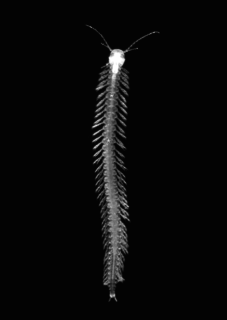
Remipedia is a class of blind crustaceans found in coastal aquifers which contain saline groundwater, with populations identified in almost every ocean basin so far explored, including in Australia, the Caribbean Sea, and the Atlantic Ocean. The first described remipede was the fossil Tesnusocaris goldichi. Since 1979, at least seventeen living species have been identified in subtropical regions around the world.

The Stenopodidea or boxer shrimps are a small group of decapod crustaceans. Often confused with Caridea shrimp or Dendrobranchiata prawns, they are neither, belonging to their own group.

Stenopus hispidus is a shrimp-like decapod crustacean belonging to the infraorder Stenopodidea. Common names include coral banded shrimp and banded cleaner shrimp.

An anchialine pool or pond is a landlocked body of water with a subterranean connection to the ocean. Anchialine pools are a feature of coastal aquifers which are density stratified, with the water near the surface being fresh or brackish, and saline water intruding from the coast below at some depth. Depending on the site, it is sometimes possible to access the deeper saline water directly in the anchialine pool, or sometimes it may be accessible by cave diving.
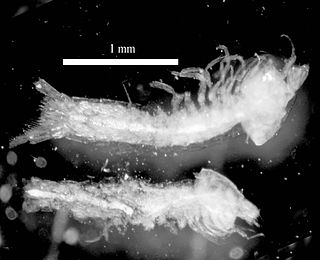
Thermosbaenacea is a group of crustaceans that live in thermal springs in fresh water, brackish water and anchialine habitats. They have occasionally been treated as a distinct superorder (Pancarida), but are generally considered to belong to the Peracarida. Due to their troglobitic lifestyle, thermosbaenaceans lack visual pigments and are therefore blind.
Barbouria is a genus of shrimp in the family Barbouriidae, comprising two species.
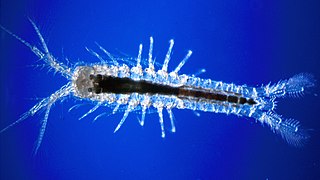
Mictocaris halope is the only species of cave crustacean in the monotypic genus Mictocaris. It is placed in its own family, Mictocarididae, and is sometimes considered the only member of the order Mictacea. Mictocaris is endemic to anchialine caves in Bermuda, and grows up to 3.5 mm (0.14 in) long. Its biology is poorly known.

Procambarus is a genus of crayfish in the family Cambaridae, all native to North and Central America. It includes a number of troglobitic species, and the marbled crayfish (marmorkrebs), which is parthenogenetic. Originally described as a subgenus for four species, it now contains 161 species in 16 subgenera.
Parhippolyte sterreri is a species of marine decapod crustacean in the family Barbouriidae, formerly placed in the genus Somersiella. It is found in marine caves around the Bahamas, Cuba and Mexico and inland anchialine caves in Bermuda.

Typhlatya is a genus of shrimp in the family Atyidae. These are small, stygobitic shrimp found in the West Mediterranean region, Caribbean region, Ascension Island and the Galápagos, although the individual species often have very small ranges. Species in this genus are found in salt, brackish and fresh waters, mostly in anchialine habitats and none in the open sea.
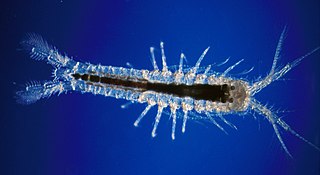
Mictacea is an monotypical order of crustaceans, originally erected for four species of small shrimp-like animals of the deep sea and anchialine caves.
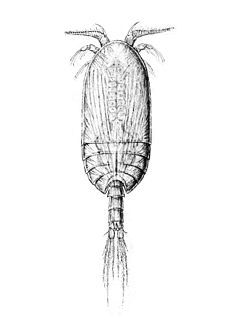
Platycopiidae is a family of copepods. Until the description of Nanocopia in 1988, it contained the single genus Platycopia. It now contains four genera, three of which are monotypic; the exception is Platycopia, with 8 species.

Stenopus spinosus is a shrimp-like decapod crustacean belonging to the infraorder Stenopodidea.
Juxtastenopus spinulatus is a species of stenopodidean shrimp. It lives in the Red Sea, and across the Indian Ocean as far east as the Philippines. It is red or pink, up to 28 mm (1.1 in) long, with enlarged third pereiopods. Originally described in the genus Engystenopus, it is now placed in the monotypic genus Juxtastenopus, in the family Stenopodidae.

Xibalbanus tulumensis is a venomous, hermaphroditic crustacean found in anchialine caves on the Yucatán Peninsula in the Caribbean Sea. This blind remipede liquefies the body contents of other crustaceans with a venom similar to that of rattlesnakes, and which includes digestive enzymes and a paralysing toxin.
Pleomothra is a genus of crustacean found in the Caribbean. First described in 1989, the genus has 2 identified species as of 2008 and is one of three genera in the family Godzilliidae.

Stenopus pyrsonotus is a shrimp-like decapod crustacean belonging to the infraorder Stenopodidea, native to the Indo-West Pacific region. Common names include flameback coral shrimp, ghost boxing shrimp and cave shrimp; the species is sometimes kept in reef aquariums.
References
- 1 2 3 4 5 6 7 8 9 10 11 Fernando Alvarez, Thomas M. Iliffe & José Luis Villalobos (2006). "Macromaxillocarididae, a new family of stenopodidean shrimp from an anchialine cave in the Bahamas, with the description of Macromaxillocaris bahamaensis, n. gen., n. sp" (PDF). Journal of Crustacean Biology . 26 (3): 366–378. doi: 10.1651/C-2658.1 . Archived from the original (PDF) on 2013-05-14. Retrieved 2011-12-07.
- 1 2 Brian Kakuk (January 27, 2011). "Oven Rock Cave". Anchialine Caves and Cave Fauna of the World. Texas A&M University at Galveston . Retrieved December 7, 2011.
- ↑ S. De Grave & C. H. J. M. Fransen (2011). "Carideorum Catalogus: the Recent species of the dendrobranchiate, stenopodidean, procarididean and caridean shrimps (Crustacea: Decapoda)". Zoologische Mededelingen . 85 (9): 195–589, figs. 1–59. ISBN 978-90-6519-200-4. Archived from the original on 2012-12-20.